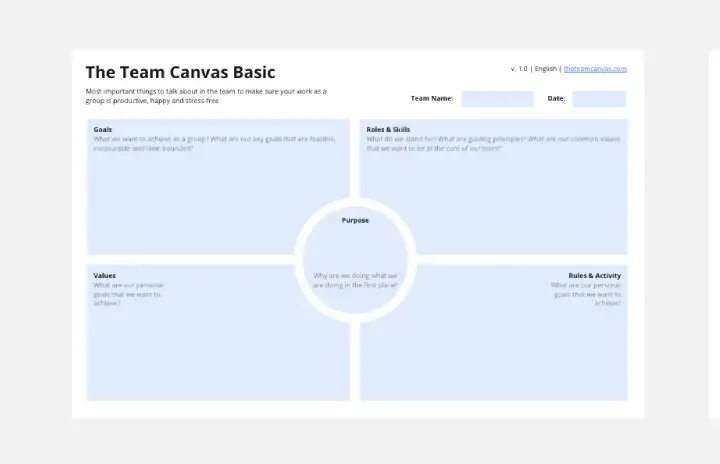The Team Canvas (Basic)
The Team Canvas Basic is a short 30 to 45 minute version of the Team Canvas framework that is suitable for starting new teams, aligning on common vision and basic agreements. It is pretty fast and works best on short projects, or when a new member joins the team.
When to use The Team Canvas
Based on our experience with startups and creative groups, it is made to smoothly start collective projects, let people learn about each other and accumulate enough momentum to get going.Team Canvas Basic works best at the following touch points:
creating a team;
kicking off a project;
welcoming new team member (e.g. freelancer joining the team);
basic team alignment meeting.
How does The Team Canvas work?
You’ll be guided through 5 key concepts:
Purpose: What is the team's purpose: the Why behind your goals? 5 mins
Goals: What are the goals for the whole team, as well as for each team member? 5 mins
Values: What are the core values that you share as a team? 5 mins
Roles & Skills: What are the roles and corresponding skills that each member brings to the table? 5 mins
Rules & Activities: What are the ground rules that you want to agree on? How are you going to communicate? How would you make your decisions? How are you going to plan, execute and evaluate them? 5 mins
This template was created by Alex Ivanov.
Get started with this template right now.
Taco Tuesday Retrospective
Works best for:
Agile Methodology, Retrospectives, Meetings
The Taco Tuesday Retrospective template offers a fun and informal approach to retrospectives, perfect for fostering team camaraderie. It provides elements for reflecting on past iterations over a casual taco-themed gathering. This template enables teams to relax, share insights, and brainstorm ideas in a laid-back atmosphere. By promoting social interaction and creativity, the Taco Tuesday Retrospective empowers teams to strengthen relationships, boost morale, and drive continuous improvement effectively.
Kanban Pizza Game
Works best for:
Agile, Kanban
The Kanban Pizza Game is an interactive way for teams to learn and apply Kanban principles. By simulating a pizza delivery process, teams experience how to visualize work, limit work in progress, and optimize flow. Through rounds of iteration and reflection, participants gain insights into continuous improvement and lean thinking, fostering collaboration and driving efficiency. Get ready to slice through inefficiencies and deliver value faster with the Kanban Pizza Game!
Agile Marketing Kanban
Works best for:
Agile, Kanban
The Agile Marketing KANBAN template adapts Kanban principles to the marketing domain, enabling teams to manage campaigns, tasks, and workflows efficiently. It provides visual boards for planning, prioritizing, and tracking marketing activities, ensuring alignment with strategic goals and timely delivery of campaigns. With customizable columns and swimlanes, this template empowers marketing teams to visualize work, limit work in progress, and optimize their processes, driving agility and effectiveness in marketing operations.
Design Sprint Kit Template
Works best for:
Agile Methodology, UX Design, Sprint Planning
With the right focused and strategic approach, five days is all it takes to address your biggest product challenges. That’s the thinking behind Design Sprint methodology. Created by Tanya Junell of Blue Label Labs, this Design Sprint Kit provides a set of lightweight templates that support the Design Sprint’s collaborative activities and voting—and maintains the energy, team spirit, and momentum that was sparked in the session. Virtual sprint supplies and prepared whiteboards make this kit especially useful for remote Design Sprint Facilitators.
I Like | I Wish | I Wonder
Works best for:
Agile
Feedback is a key part of any project development and crucial to the iterative process.
Sprint Planning with Jira Template
Works best for:
Sprint Planning, Agile
The Sprint Planning with Jira template in Miro is a powerful tool designed to streamline and enhance your sprint planning sessions. One of the key benefits of this template is its Jira integration, which saves time and effort when planning and aligning teams. By integrating directly with Jira, the template allows for seamless import and management of tasks, ensuring that all your Jira tickets are up-to-date and easily accessible within Miro. This reduces the need for manual updates and minimizes errors, making the planning process more efficient and effective.
